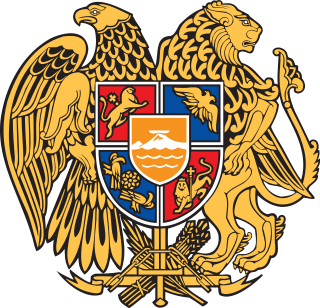 W
WThe national coat of arms of Armenia was adopted on April 19, 1992, by resolution of the Armenian Supreme Council. On June 15, 2006, the Armenian Parliament passed the law on the state coat of arms of Armenia.
 W
WThe blazon of the coat of arms of the Princess of Asturias is given by a Royal Decree 979 on 30 October 2015 which was an amendment of the Royal Decree 1511 dated Madrid 21 January 1977, which also created her guidon and her standard.
 W
WThe current coat of arms of the Republic of Austria has been in use in its first forms by the First Republic of Austria since 1919. Between 1934 and the German annexation in 1938, the Federal State used a different coat of arms, which consisted of a double-headed eagle. The establishment of the Second Republic in 1945 saw the return of the original arms, with broken chains added to symbolise Austria's liberation. In 1981 the Wappen der Republik Österreich (Bundeswappen) described the blazon in the Federal Constitutional Law (Bundes-Verfassungsgesetz, B-VG). With this change of law it was defined that the specific drawing is to codificate in an own statute law and that all other versions of the coat of arms of Austria were no longer in law. In accordance to this the Wappengesetz from 1984 and the drawing of the actual Wappen der Republik Österreich is in Austrian law. The often used ″Bundesadler″ is only a synonymous term in colloquial language.
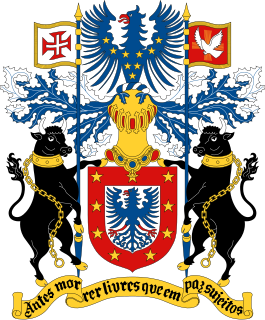 W
WThe coat of arms of the Azores is nine gold stars superimposed on a red bordure, representing the nine islands of the archipelago. The bordure surrounds a silver shield on which a blue eagle is displayed with wings elevated and with red feet, beak, and tongue. The crest is a closed helm in gold lined with red, surmounted by a wreath and mantling of silver and blue, topped by another blue eagle on which are superimposed the same nine gold stars.
 W
WThe Arms of Canada, also known as the Royal Coat of Arms of Canada or formally as the Arms of Her Majesty The Queen in Right of Canada, is, since 1921, the official coat of arms of the Canadian monarch and thus also of Canada. It is closely modelled after the royal coat of arms of the United Kingdom with French and distinctive Canadian elements replacing or added to those derived from the British version.
 W
WThe coat of arms of Cantabria has a rectangular shield, round in base and the field is party en fess. In field azure, a tower or crenellated and masoned, port and windows azure, to its right a ship in natural colours that with its bow has broken a chain sable going from the tower to the dexter flank of the shield. At the base, sea waves argent and azure, all surmounted in chief by two male heads, severed and haloed. In field gules, a disc-shaped stele with geometric ornaments of the kind of the Cantabrian steles of Barros or Lombera. The crest is a closed royal crown, a circle of jeweled gold, made up of eight rosettes in the shape of acanthus leaves, only five visible, interpolated with pearls, and with half-arches topped with pearls raising from each leaf and converging in an orb azure, with submeridian and equator or, topped with cross or. The crown, covered in gules.
 W
WThe national emblem of Cape Verde contains a circle within which is written the name of the nation in Portuguese. Within the circle are a torch and triangle, symbols of freedom and national unity. At the top of the shield is a plumbob, a symbol of righteousness; three chain links are at the bottom. This emblem replaces the earlier variant with the seashell that had been in use since independence. The current emblem was adopted in 1992.
 W
WThe coat of arms of the London Borough of Enfield is the official heraldic arms of the London Borough of Enfield, granted on 15 August 1966.
 W
WThe Royal coat of arms of Great Britain was the coat of arms representing royal authority in the sovereign state of the Kingdom of Great Britain, in existence from 1707 to 1801. The kingdom came into being on 1 May 1707, with the political union of the kingdom of Scotland and the kingdom of England, which included Wales. With the 1706 Treaty of Union, it was agreed to create a single kingdom, encompassing the whole of the island of Great Britain and its outlying islands, but not Ireland, which remained a separate realm under the newly created British crown.
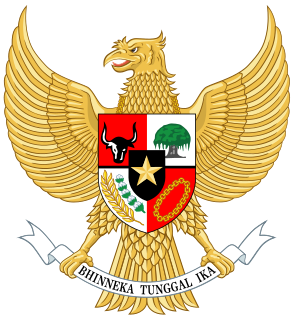 W
WThe national emblem or coat of arms of Indonesia is called Garuda Pancasila. The main part of Indonesian national emblem is the Garuda with a heraldic shield on its chest and a scroll gripped by its legs. The shield's five emblems represent Pancasila, the five principles of Indonesia's national ideology. The Garuda claws gripping a white ribbon scroll inscribed with the national motto Bhinneka Tunggal Ika written in black text, which can be loosely translated as "Unity in Diversity". Garuda Pancasila was designed by Sultan Hamid II from Pontianak, supervised by Sukarno, and was adopted as the national emblem on 11 February 1950.
 W
WThe seal of the Marshall Islands consists of a blue background, which represents the sea. On the blue background, there is an angel with outstretched wings symbolizing peace. Behind the angel, there are two islands with an outrigger canoe and a palm tree. On the upper left and right in the shield are a red and white stripe. Behind the shield there is a stylized nautical chart. In the ring above the shield is the phrase Republic of the Marshall Islands, and below, the national motto, Jepilpilin ke Ejukaan.
 W
WThe coat of arms of Navarre is the heraldic emblem which for centuries has been used in Navarre. It was adopted as one of the official symbols of the Chartered Community of Navarre and is regulated by Foral Law 24/2003. It is commonly used by Navarrese municipalities in their own arms.
 W
WThe coat of arms of Oxford is the official heraldic arms of Oxford, used by Oxford City Council.
 W
WThe coat of arms of the Prince of Wales is the official heraldic insignia of the Prince of Wales, a title traditionally granted to the heir apparent to the reigning monarch of the United Kingdom of Great Britain and Northern Ireland, formerly the Kingdom of Great Britain and before that the Kingdom of England.
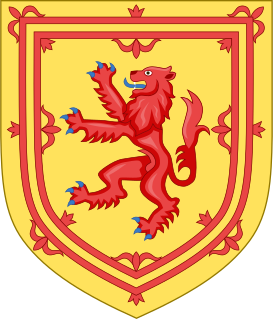 W
WThe royal arms of Scotland is the official coat of arms of the King of Scots first adopted in the 12th century. With the Union of the Crowns in 1603, James VI inherited the thrones of England and Ireland and thus his arms in Scotland were now quartered with the arms of England with an additional quarter for Ireland also added. Though the kingdoms of England and Scotland would share the same monarch, the distinction in heraldry used in both kingdoms was maintained. When the kingdoms of Scotland and England were united under the Acts of Union 1707 to form the Kingdom of Great Britain, no single arms were created, thereby maintaining the convention that the royal arms used in Scotland would continue to differ from those used elsewhere.
 W
WThe coat of arms of Spain represents Spain and the Spanish nation, including its national sovereignty and the country's form of government, a constitutional monarchy. It appears on the flag of Spain and it is used by the Government of Spain, the Cortes Generales, the Constitutional Court, the Supreme Court, and other state institutions. Its design consists of the arms of the medieval kingdoms that would unite to form Spain in the 15th century, the Royal Crown, the arms of the House of Bourbon, the Pillars of Hercules and the Spanish national motto: Plus Ultra. The Monarch, the heir to the throne and some institutions like the Senate, the Council of State and the General Council of the Judiciary have their own variants of the coat of arms.
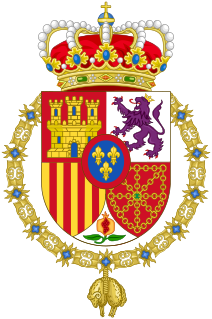 W
WThe coat of arms of the King of Spain is the heraldic symbol representing the monarch of Spain. The current version of the monarch's coat of arms was adopted in 2014 but is of much older origin. The arms marshal the arms of the former monarchs of Castile, León, Aragon, and Navarre.
 W
WThe Coat of arms of the Prince of Spain was set out in the Spanish Decree 814 of 22 April 1971, by which the Rules for Flags, Standards, Guidons, Banners, and Badges were adopted.
 W
WThe Coat of arms of the Second Spanish Republic was the emblem of the Second Spanish Republic, the democratic government that existed in Spain between April 14, 1931, when King Alfonso XIII left the country, and April 1, 1939, when the last of the Republican forces surrendered to Francoist forces at the end of the Spanish Civil War.
 W
WThe royal coat of arms of the United Kingdom, or the royal arms for short, is the official coat of arms of the British monarch, currently Queen Elizabeth II. These arms are used by the Queen in her official capacity as monarch of the United Kingdom. Variants of the royal arms are used by other members of the British royal family, by the British Government in connection with the administration and government of the country, and some courts and legislatures in a number of Commonwealth realms. A Scottish version of the royal arms is used in and for Scotland. The arms in banner form serve as basis for the monarch's official flag, the Royal Standard.
 W
WThe Coat of arms of the Wakefield District was granted in 1990. Between 1974 and 1990, the council did not have arms that represented its governance of the expanded metropolitan district of the City of Wakefield, and used the arms of the County Borough of Wakefield. Arms had been granted to the district's constituent city and towns, but an application to the College of Arms was made for a unifying achievement.
 W
WZazpiak Bat is a heraldic nickname for the Basque coat of arms which includes the arms of the seven provinces mentioned, stressing their unity. It was designed by the historian Jean de Jaurgain in 1897 for the Congrès et Fêtes de la Tradition basque celebrated at Saint-Jean-de-Luz.